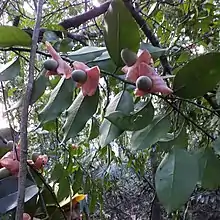Harmandia mekongensis
Harmandia mekongensis is a species of flowering plants. It is the only species in the monotypic genus of Harmandia.[1] In the APG IV system, the genus is placed in the family Olacaceae.[2][1][3]: 9 Other sources place it in the segregate family Aptandraceae.[4]
| Harmandia mekongensis | |
|---|---|
 | |
| Scientific classification | |
| Kingdom: | Plantae |
| Clade: | Tracheophytes |
| Clade: | Angiosperms |
| Clade: | Eudicots |
| Order: | Santalales |
| Family: | Olacaceae |
| Genus: | Harmandia Pierre ex Baill.[1] |
| Species: | H. mekongensis |
| Binomial name | |
| Harmandia mekongensis Baill.[1] | |
| Synonyms | |
| |
Its native range is Indo-China to Sumatra, Malay Peninsula and Borneo in western Malesia.[1][3]: 10
Taxonomy
The genus name of Harmandia is in honour of Jules Harmand (1845–1921), a French naval doctor and naturalist, who collected plants in south-east Asia, Japan and present-day Sri Lanka.[5] The Latin specific epithet of mekongensis is named after the Mekong River from where the plant was collected. It was first described and published in Bull. Mens. Soc. Linn. Paris Vol.2 on page 770 in 1889.[1]
Description
The tree grows to a height between 6 and 40 metres. Its bark is flaky comprising an outer pale layer and a whitish or yellowish inner layer, the wood is pale yellow. The oblong or lanceolate leaves with 5–9 cm long and 2.5–4 cm wide, they have smooth surfaces and are brittle when dry.[3]: 10
The flowers grow from a raceme 1–1.5 long cm made of 5 flowers. Each flower is small and green. Its fruit is a fleshy, green ovoid drupe with an orange base 2.5–3 cm long by 1.3–2 wide growing out of a huge calyx; it changes colour to yellow or pink-orange when ripe. The seed is 0.5 mm long.[3]: 10
References
- "Harmandia Pierre ex Baill". Plants of the World Online. Royal Botanical Gardens, Kew. Retrieved 14 May 2021.
- Angiosperm Phylogeny Group (2016). "An update of the Angiosperm Phylogeny Group classification for the orders and families of flowering plants: APG IV". Botanical Journal of the Linnean Society. 181 (1): 1–20. doi:10.1111/boj.12385.
- Sleumer, H. (1972). "Olacaceae". Flora Malesiana. 10 (1): 1–29 – via Naturalis Institutional Repository.
- Stevens, P.F. "Aptandraceae". Angiosperm Phylogeny Website. Retrieved 2021-07-18.
- Burkhardt, Lotte (2018). Verzeichnis eponymischer Pflanzennamen – Erweiterte Edition [Index of Eponymic Plant Names – Extended Edition] (pdf) (in German). Berlin: Botanic Garden and Botanical Museum, Freie Universität Berlin. doi:10.3372/epolist2018. ISBN 978-3-946292-26-5. Retrieved 1 January 2021.